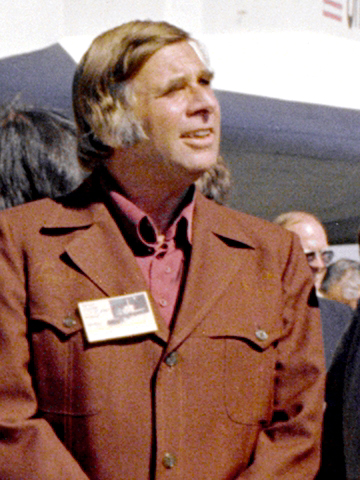|
Set Redress
In film, a redress is the redecoration of an existing movie set so that it can double for another set. This saves the trouble and expenses of constructing a second, new set, though they face the difficulty of doing it so the average viewer does not notice the same set is reused. Also there could be logistical problems, such as conflicting shooting schedules, continuity if the set is not quite the same as it was (if it should be the same) or different (if it should be). The latter problem arises because the set dresser may be unaware of changes created by the action. Examples A good example of a successful redress occurred in the film '' Star Trek II: The Wrath of Khan'' where the bridges of the ''Enterprise'' and the ''Reliant'' were filmed on the same set. Some of the reasons for its success are as follows: * All the scenes on the ''Reliant'' bridge were shot after the scenes on the ''Enterprise'' bridge, eliminating difficulty with continuity and conflicting shooting schedules. ... [...More Info...] [...Related Items...] OR: [Wikipedia] [Google] [Baidu] |
|
 |
Film
A film, also known as a movie or motion picture, is a work of visual art that simulates experiences and otherwise communicates ideas, stories, perceptions, emotions, or atmosphere through the use of moving images that are generally, since the 1930s, synchronized with sound and (less commonly) other sensory stimulations. Etymology and alternative terms The name "film" originally referred to the thin layer of photochemical emulsion on the celluloid strip that used to be the actual medium for recording and displaying motion pictures. Many other terms exist for an individual motion-picture, including "picture", "picture show", "moving picture", "photoplay", and "flick". The most common term in the United States is "movie", while in Europe, "film" is preferred. Archaic terms include "animated pictures" and "animated photography". "Flick" is, in general a slang term, first recorded in 1926. It originates in the verb flicker, owing to the flickering appearance of early films ... [...More Info...] [...Related Items...] OR: [Wikipedia] [Google] [Baidu] |
 |
Movie Set
Set construction is the process undertaken by a construction manager to build full-scale scenery, as specified by a production designer or art director working in collaboration with the director of a production to create a set for a theatrical, film, or television production. The set designer produces a scale model, scale drawings, paint elevations (a scale painting supplied to the scenic painter of each element that requires painting), and research about props, textures, and so on. Scale drawings typically include a ground plan, elevation, and section of the complete set, as well as more detailed drawings of individual scenic elements which, in theatrical productions, may be static, flown, or built onto scenery wagons. Models and paint elevations are frequently hand-produced, though in recent years, many Production Designers and most commercial theatres have begun producing scale drawings with the aid of computer drafting programs such as AutoCAD or Vectorworks. Thea ... [...More Info...] [...Related Items...] OR: [Wikipedia] [Google] [Baidu] |
 |
The Wrath Of Khan
''Star Trek II: The Wrath of Khan'' is a 1982 American science fiction film directed by Nicholas Meyer and based on the television series ''Star Trek''. It is the second film in the ''Star Trek'' film series following '' Star Trek: The Motion Picture'' (1979), and is a sequel to the television episode "Space Seed" (1967). The plot features Admiral James T. Kirk (William Shatner) and the crew of the starship USS ''Enterprise'' facing off against the genetically engineered tyrant Khan Noonien Singh (Ricardo Montalbán). When Khan escapes from a 15-year exile to exact revenge on Kirk, the crew of the ''Enterprise'' must stop him from acquiring a powerful terraforming device named Genesis. The film is the beginning of a three-film story arc that continues with the film '' Star Trek III: The Search for Spock'' (1984) and concludes with the film '' Star Trek IV: The Voyage Home'' (1986). After the lackluster critical response to the first film, series creator Gene Roddenberry wa ... [...More Info...] [...Related Items...] OR: [Wikipedia] [Google] [Baidu] |
 |
USS Enterprise (NCC-1701)
USS ''Enterprise'' is a series of Fiction, fictional starships in the ''Star Trek'' media franchise. ''Enterprise'' is the main setting of Star Trek: The Original Series, the original ''Star Trek'' television series (1966–69), nine Star Trek films, ''Star Trek'' films, and ''Star Trek: Strange New Worlds'' (2022–present). The vessels carry their crew on a mission "to explore strange, new worlds; to seek out new life and new civilizations; to boldly go where no man has gone before." Matt Jefferies designed the ''Enterprise'' for television, and its core components – a flying saucer-shaped primary hull, two offset engine Nacelle, nacelles, and a cylindrical secondary hull – persisted across several television and film redesigns. The vessel influenced the design of subsequent franchise spacecraft, including Starship Enterprise, other vessels named ''Enterprise'', and the model filmed for the original ''Star Trek'' TV series has been on display for decades at the National A ... [...More Info...] [...Related Items...] OR: [Wikipedia] [Google] [Baidu] |
|
Walter Koenig
Walter Marvin Koenig (; born September 14, 1936) is an American actor and screenwriter. He began acting professionally in the mid-1960s and quickly rose to prominence for his supporting role as Ensign Pavel Chekov in '' Star Trek: The Original Series'' (1967–1969). He went on to reprise this role in all six original-cast ''Star Trek'' films, and later voiced President Anton Chekov in '' Star Trek: Picard'' (2023). He has also acted in several other series and films including '' Goodbye, Raggedy Ann'' (1971), '' The Questor Tapes'' (1974), and ''Babylon 5'' (1993). In addition to his acting career, Koenig has made a career in writing as well and is known for working on '' Land of the Lost'' (1974),'' Family'' (1976), '' What Really Happened to the Class of '65?'' (1977) and ''The Powers of Matthew Star'' (1982). Early life Koenig was born in Chicago, Illinois, the son of businessman Isadore Koenig and his wife Sarah (née Strauss). They moved to the Inwood neighborhood of Man ... [...More Info...] [...Related Items...] OR: [Wikipedia] [Google] [Baidu] |
|
|
Motif (music)
In music, a motif () or motive is a short musical idea, a Salience (neuroscience), salient recurring Figure (music), figure, musical fragment or succession of notes that has some special importance in or is characteristic of a musical composition, composition. The motif is the smallest structural unit possessing theme (music), thematic identity. History The defines a motif as a "melodic, rhythmic, or harmonic cell (music), cell", whereas the 1958 maintains that it may contain one or more cells, though it remains the smallest analyzable element or phrase within a subject (music), subject. It is commonly regarded as the shortest subdivision of a Theme (music), theme or Phrase (music), phrase that still maintains its identity as a musical idea. "The smallest structural unit possessing thematic identity". The New Grove Dictionary of Music and Musicians, Grove and Éditions Larousse, Larousse also agree that the motif may have harmonic, melodic and/or rhythmic aspects, Grove a ... [...More Info...] [...Related Items...] OR: [Wikipedia] [Google] [Baidu] |
|
 |
Lighting
Lighting or illumination is the deliberate use of light to achieve practical or aesthetic effects. Lighting includes the use of both artificial light sources like lamps and light fixtures, as well as natural illumination by capturing daylight. Daylighting (architecture), Daylighting (using windows, skylights, or Architectural light shelf, light shelves) is sometimes used as the main source of light during daytime in buildings. This can save energy in place of using artificial lighting, which represents a major component of energy consumption in buildings. Proper lighting can enhance task performance, improve the appearance of an area, or have positive psychological effects on occupants. Indoor lighting is usually accomplished using light fixtures, and is a key part of interior design. Lighting can also be an intrinsic component of landscaping, landscape projects. History With the Control of fire by early humans, discovery of fire, the earliest form of artificial lighting used ... [...More Info...] [...Related Items...] OR: [Wikipedia] [Google] [Baidu] |
|
United Federation Of Planets
In the fictional universe of ''Star Trek'', the United Federation of Planets (UFP) is the interstellar government with which, as part of its space force Starfleet, most of the characters and starships of the franchise are affiliated. Commonly referred to as "the Federation", it was introduced in the Star Trek: The Original Series, original ''Star Trek'' television series. The survival, success, and growth of the Federation and its principles of freedom have become some of the ''Star Trek'' Media franchise, franchise's central themes. The Federation is an organization of numerous planetary sovereignties, including Earth and Vulcan (Star Trek), Vulcan. The franchise focuses on Starfleet, the exploration and defense arm of the Federation, rather than the government. Viewers are rarely given details of the internal workings of the government; however, many episodes refer to the rules and laws that the Federation imposes on the characters and their adventures. Development Early in th ... [...More Info...] [...Related Items...] OR: [Wikipedia] [Google] [Baidu] |
|
 |
Trekkie
A Trekkie (a portmanteau of "trek" and "junkie") or Trekker is a fan of the ''Star Trek'' franchise, or of specific television series or films within that franchise. The show developed a following shortly after it premiered, with the first fanzine premiering in 1967. The first fan convention took place the year the original series ended. The degree of Trekkies' devotion has produced conflicted feelings among the cast and crew of the show. Creator Gene Roddenberry initially encouraged the fan participation, but over the years became concerned that some fans treated the show with a quasi-religious zeal as though it were "scripture." While some stars have been vocally critical of the franchise's most devoted fans, others including Sir Patrick Stewart have defended Trekkies. There has been some disagreement within the fandom as to the distinction between the terms "Trekker" and "Trekkie." Some characterize Trekkers are "more serious" in comparison to the "bubble-headed" Trekkies, w ... [...More Info...] [...Related Items...] OR: [Wikipedia] [Google] [Baidu] |
|
We're Not Married
''We're Not Married!'' is a 1952 American anthology romantic comedy film directed by Edmund Goulding Edmund Goulding (20 March 1891 – 24 December 1959) was a British screenwriter and film director. As an actor early in his career he was one of the 'Ghosts' in the 1922 silent film '' Three Live Ghosts'' alongside Norman Kerry and Cyril Chadwic .... It was released by 20th Century Fox. The screenplay was written by Nunnally Johnson, while the story was adapted by Dwight Taylor (writer), Dwight Taylor from Gina Kaus's and Jay Dratler's unpublished work "If I Could Remarry". The film stars Ginger Rogers, Fred Allen, Victor Moore, Marilyn Monroe, David Wayne, Eve Arden, Paul Douglas (actor), Paul Douglas, Eddie Bracken, and Mitzi Gaynor. Co-stars include Louis Calhern, Zsa Zsa Gabor, James Gleason, Paul Stewart (actor), Paul Stewart, and Jane Darwell. Plot When elderly Mr. Bush is appointed justice of the peace, he starts marrying couples on Christmas Eve. However, his app ... [...More Info...] [...Related Items...] OR: [Wikipedia] [Google] [Baidu] |